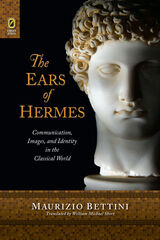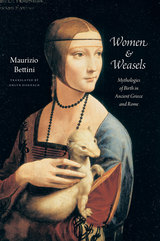2 books by Bettini, Maurizio

The Ears of Hermes
Communication, Images, and Identity in the Classical World
Maurizio Bettini
The Ohio State University Press, 2011
Though in many respects similar to us moderns, the Greeks and Romans often conceived things differently than we do. The cultural inheritance we have received from them can therefore open our eyes to many “manners of life” we might otherwise overlook. The ancients told fascinating—but different—stories; they elaborated profound—but different—symbols. Above all, they confronted many of the problems we still face today—memory and forgetfulness; identity and its strategies; absolutist moralism and behavioral relativity—only in profoundly different ways, since their own cultural forms and resources were different. In The Ears of Hermes: Communication, Images, and Identity in the Classical World, renowned scholar and author Maurizio Bettini explores these different cultural experiences, choosing paths through this territory that are diverse and sometimes unexpected: a little-known variant of a myth or legend, such as that of Brutus pretending, like Hamlet, to be a Fool; a proverb, like lupus in fabula (the wolf in the tale), that expresses the sense of foreboding aroused by the sudden arrival of someone who was just the subject of conversation; or great works, like Plautus’ Amphitruo and Vergil’s Aeneid, where we encounter the mysteries of the Doppelgänger and of “doubles” fabricated to ease the pain of nostalgia. Or the etymology of a word—its own “story”—leads us down some unforeseen avenue of discovery. While scholarly in presentation, this book, in an elegant English translation by William Michael Short, will appeal not only to classicists but also students, as well as to anthropologists and historians of art and literature beyond classics.
[more]

Women and Weasels
Mythologies of Birth in Ancient Greece and Rome
Maurizio Bettini
University of Chicago Press, 2013
If you told a woman her sex had a shared, long-lived history with weasels, she might deck you. But those familiar with mythology know better: that the connection between women and weasels is an ancient and favorable one, based in the Greek myth of a midwife who tricked the gods to ease Heracles’s birth—and was turned into a weasel by Hera as punishment. Following this story as it is retold over centuries in literature and art, Women and Weasels takes us on a journey through mythology and ancient belief, revising our understanding of myth, heroism, and the status of women and animals in Western culture.
Maurizio Bettini recounts and analyzes a variety of key literary and visual moments that highlight the weasel’s many attributes. We learn of its legendary sexual and childbearing habits and symbolic association with witchcraft and midwifery, its role as a domestic pet favored by women, and its ability to slip in and out of tight spaces. The weasel, Bettini reveals, is present at many unexpected moments in human history, assisting women in labor and thwarting enemies who might plot their ruin. With a parade of symbolic associations between weasels and women—witches, prostitutes, midwives, sisters-in-law, brides, mothers, and heroes—Bettini brings to life one of the most venerable and enduring myths of Western culture.
[more]
READERS
Browse our collection.
PUBLISHERS
See BiblioVault's publisher services.
STUDENT SERVICES
Files for college accessibility offices.
UChicago Accessibility Resources
home | accessibility | search | about | contact us
BiblioVault ® 2001 - 2024
The University of Chicago Press









